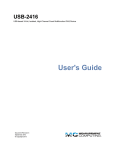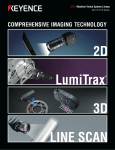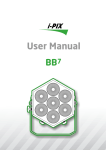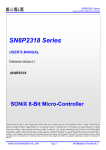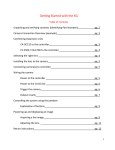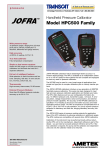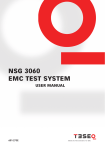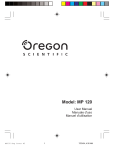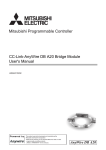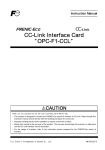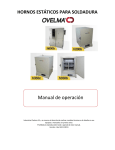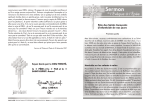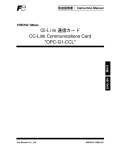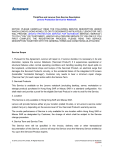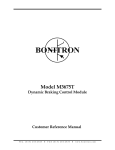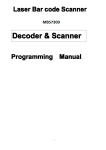Download CV-X100 Ver.2
Transcript
NEW Easy Setup, Auto-Teaching Machine Vision System CV-X100 Series Human-level judgement readily available for anybody CV-X100 Ver.2 A new function that allows anyone to quickly and easily achieve everything from setup to confirmation of inspection standards. 01 Auto-Teach 02 Inspection Dimensions/ Geometry Tool The high-precision measurement requires nothing more than clicks Human-like sense of judgement 07 Learns non-defective workpieces Non-defective Non-defective Non-defective product product product Non-defective Non-defective product product Non-defective Non-defective Non-defective product product product The different workpieces from these “learned ones” are judged as “defective workpieces”. The image sensor auto-teaches variations such as product colour and individual differences that exist in the non-defective workpieces. “Auto-Teach Inspection” is a thinking tool which recognises the similarity with the non-defective workpieces instead of detecting the defective one. This feature eliminates the conventional unstable factors. P.4 2 Setting is completed just by following steps. KEYENCE original appearance inspection tools can also be used at the same time. P.7 P.6 Non-defective product 08 Utilities Professional knowledge adjustments incorporated into utilities “Tool Adjustment Navigation” is for false positive correction, and “Camera Installation Replication” for the horizontal deployment of the line. Those make the professional adjustment know-how into utilities. P.14 Connector Tools Complex connector inspection setting is completed just by following steps Measurement is completed just by clicking the point to measure. Complex calculation elements that were conventionally needed for dimensional geometric measurement have been completely eliminated. Just run non-defective workpieces to set Non-defective product 03 Tool Catalogue Your desired selection of inspection tools achieved through the catalogue Tool Catalogue enables intuitive tool selection from applications such as “Presence/ Discrimination inspection” and “Stain/ Flaw inspection”. P.17 04 Measurement Algorithm The evolving algorithm delivers reliable inspection The latest algorithm groups that have continued to evolve based on long fieldproven experience, strongly support stable inspection. 05 Image Optimisation 06 User Interface Ideal imaging according to Optimal operation screen inspection targets and equipment selection possible through pre-defined options Before After Various tools are provided to dramatically optimise inspection images according to inspection targets, installation environments, and equipment motions. Optimal screen configuration is completed just by selecting from the catalogue on the screen and a specialised operator menu setting is completed just by selecting the setting parameters. P.10 P.8 P.12 NEW 09 10 Security Robust security preserves your assets LOCK ! Passwords of up to 32 digits can be set. Place restrictions on editing and browsing settings to prevent leakage of user know-how embedded in the programme. P.18 User Manual Auto-Generation A single button click to create customised user manual based on applied settings It is possible to create a dedicated manual according to the settings with a single button. This feature supports the operation after introduction, the most important for the image processing. P.19 11 Easy Setup, Auto-Teaching Machine Vision System CV-X100 Series Communication and Control A wide variety of communication methods compatible with existing systems PLC-Link Supports linking to PLCs made by several manufacturers as well as EtherNet/IP and PROFINET. P.20 3 01 Auto-Teach Inspection Tool NEW Colour The newly incorporated “Auto-Teach inspection tool” that uses the image sensor to learn variations and individual differences that exist in the non-defective workpieces and recognises workpieces that differ from these as defective An inspection tool that “auto-teaches”; Just running non-defective workpieces completes the application setup workpieces. These algorithms, which are unlimitedly close to the human sensation, eliminate unstable elements to successfully guide on-site inspection. Settings are performed just by running non-defective workpieces, and resolves the conventional need for high expertise and the complication of settings. This is an inspection tool Just run non-defective workpieces that makes it possible for anyone to achieve and maintain the stable inspection. Setting completed! New invention! Non-defectives learnt! “Those different from learnt nondefectives” are detected as “defectives”. Non-defective Different type Incomplete printing Flaw Defectives not expected at the time of setting can also be detected. Ideal for the following applications: 1 Setting is often required due to 2 There are many points to 3 Complex shaped positions to 4 Variable non-defectives Misarrangement inspection for boxes of tissues Plating defect inspection for lead frames Flaw inspection for connector housings Assembly defect inspection for instrument panel buttons multiple product types Even with many product types, setting is completed just by running non-defective workpieces. A wide variety of product type elements, including colour, shape, and pattern can be handled with a single tool. 4 inspect Complex setting with many points to inspect can be covered by the “Auto-Teach Inspection Tool” alone. No colour setting is required either. inspect Since this tool learns the entire workpiece including the profile, you do not have to set multiple regions according to complex shapes of workpieces. It is possible to prevent non-defective workpieces from being rejected mistakenly because this tool learns and inspects variations such as different thicknesses caused by different lighting conditions, which can occur for nondefective workpieces. ■ Easy 3 steps auto-teaches the full colour information by pixel! A confusion-free step method is adopted for setting. In addition to basic 3-step setting, a verification step is also available. Part Region 1 Locate 2 Inspection 3 Auto Just surround the featured region. Just surround the region to be inspected. Teaching A A ■ Learning Full Colour information The variability range of the non-defective workpieces is determined by learning all full colour information by pixel. The exact auto-teach is performed even in the non-defective colour shading which is not judged by the black & white. Variability range of non-defective Learning data Learns full colour information Just run nondefective workpieces. ■ Helpful in realising easy operation Cut Incorrect Learning function Set Auto Threshold function Defective workpieces are automatically eliminated even if they are mixed-in during auto-teach. It is possible to preclude the human errors by the image sensor. Automatically calculates and sets threshold values from the learned non-defective workpieces. ■ “Auto-Teach Inspection Adjustment Navigation” ensures learnt information to be updated This utility enables anyone to perform “additional learning” to widen the variable range allowed for non-defective workpieces. Unnecessary additional learning is prevented by comparing images with defective samples during additional learning. Additionally learns images judged as non-defectives Images are checked to judge NG archived images Compares them with pre-registered defective samples Unnecessary additional learning prevented! It is possible to restore the conditions before additional learning if a defective sample has been judged as OK. 5 02 Dimensions/Geometry Tool High-precision measurement can be done intuitively through simple mouse operations Conventional Combination of multiple settings and calculation is required PosX=X(ISect(Line(line1_1. xy, line1_2. xy), Line(line2_1. xy, line2_2. xy))) PosY=Y(ISect(Line(line1_1. xy, line1_2. xy), Line(line2_1. xy, line2_2. xy))) Create settings that will detect a line in the left area Dimensions/geometry tool Create settings that will detect a line in the top area Calculate intersecting coordinates between 2 lines with the calculation function Specify just with the mouse Detected! NEW In most cases, dimension/geometric measurement requires multiple tools and complicated calculation processing. With the CV-X100 Series, dimension/geometric tools that resolve this complicated processing with a clicking alone has been prepared. Because point and straight line information from other tools can also be referenced, it is possible to construct programme settings that are simpler and easier to operate. A rich variety of geometry tools that allow you to “just choose” Points Distance Point/Line Distance Lines Distance Point/Circle Distance Line/Circle Distance Circles Distance Line Passing Two Points Bisection of Two Lines Angle Formed by Two Lines Line/V-Line Intersection Two Lines Intersection Centre of Quadrangle Midpoint of Points Circle Passing Three Points Easy scaling with any image size Even for applications 1 where you would like to perform operation with full scale values instead of pixels, it is Scaling possible to easily convert to full scale with specialised scaling settings. Measure the target (Can select width or pitch) Input the full scale 2 values for the inspection region Convert to full 3 scale and display 10.000 mm 312.8 px APPLICATION Even complex shaped objects such as below can be measured quite easily. Two Lines Intersection Select the feature to be executed, and 6 Just specify target lines with the mouse Easy detection! It is also possible to reference coordinates, circles, or lines from other tools that have already had their settings completed! Capacitor Press parts Label 03 Connector Tools Conventionally, inspection setting for connectors with various items and points to be measured requires a significant amount of man-hours. With CV-X100 connector tools, this can be done by anyone simply by following steps. Complex connector inspection setting can be completed just by following steps ■ Our step method enables ANYBODY to carry out connector inspection EASILY Connector inspection that requires various items to be inspected for each product type and shape Inspection tools that fully support appearance inspection onnector C adjustment menu Purpose-specific, guided navigation is available, including “Change Component” and “Change Pin Number”. This allows anyone to make necessary modification. Pin Position Tolerance (Horizontal) Pin Flatness Pitch End Pins Distance Pin Position Tolerance (Vertical) Gap Vertical Distance Frame Tilt Housing1 Ends Distance Setting just one point enables automatic deployment in the remaining areas! Connector Appearance Inspection Existing tools can be incorporated into appearance inspection for resin overlaps, short-circuits, and flaws on housings. Connector inspection is fully supported with KEYENCE’s accumulated appearance inspection expertise for image processing. “Stain”, “Blob”, “Area”, “Intensity”, “Trend edge position” and “Trend edge width” tools are “multi-region” compatible, which enables simultaneous deployment in multiple areas. This significantly reduces setting and adjustment man-hours required for connector-specific multi-point inspection. Image stitching function First image Appearance Insp. (Trend Edge Pos.) Appearance Inspection (Area) Appearance Inspection (Blob) Appearance Insp. (Trend Edge Wd.) Appearance Inspection (Stain) Appearance Insp. (Intensity) Second image + Multiple split-captured images can easily be stitched into one image. Stitched image Setting completed! All you have to do for dimension measurement is to select from various pre-defined connector inspection tools Can be completed just by following steps specific to connector inspection Just specify a pin or stitching point Connector dedicated operation screen The operation screen most suitable for the connector inspection can be created just by selecting from the catalogue. 7 04 Measurement Algorithm A variety of standard measurement algorithms are available. Auto-Teach Inspection Area Pattern Search ShapeTrax2 Edge Position Edge Angle Edge Width Edge Pitch Edge Pairs Stain Blob Trend Edge Position Trend Edge Width Trend Edge Stain Intensity Inspect Colours OCR 1D Code Reader 2D Code Reader Auto-Teach Insp. (Pattern Search) The evolving algorithm supports stable measurement ShapeTrax2TM An advanced search tool that combines high robustness, high speed, and high precision High robustness that performs accurate searches even under poor conditions Registered image Stain Defect Unclear profile Inverted tones A de-facto standard for appearance inspection tool A stain tool is incorporated to realise the appearance inspection without eliminating the nondefective workpieces. A variety of parameters such as size, density, shape, and count are used to accurately find the flaw that you wish to detect. Flaw detection for resin cap A small flaw is found in the side of the resin cap. 8 Flaw detection for non-woven fabric cloth (fine colour) The stain inspection tool is available for the stable detection of the flaw only and ignoring the influence of the R surface of the side. The full colour information captured by the colour camera is directly processed. Regardless of any colour variation against the background, detection can be made. Ultra high-speed processing Ultra high precision ShapeTrax2 achieves the significant high-speed performance by the fundamental review of the processing algorithms. It gains maximum 10 times faster than conventional speed. In addition, the processing time increases only by a little even for a large capacity image such as 5 megapixel, and the high-speed processing can be made. At 0.025 pixels, a search accuracy that is equivalent to the best in the industry is achieved along with linearity and repeatability. Demands to improve search precision through target miniaturisation and changes to high-accuracy are supported. Trend edge stain Optimised for flawed object Detects the flaw on the profile of the product. The profile is automatically extracted just by setting the inspection region to surround it. In addition to geometric shapes such as circles and straight lines, the oval or the profile with complex shape consisting of the free curve is supported. The flaw that occurred on the corner is detected. Even if the product profile is changed, the reference model follows it to catch only the changed segment. The flaw occurred that on the line is detected. Only the change of flaw is caught against the reference line. OCR 1D/2D code readers Strong against variations in the on-site capture environment! Executes reading and NEW inspection simultaneously The OCR function is incorporated, which enables recognition of the strings only with the character Reads the 1D/2D code printed on the target workpiece. This function leads registration and region setting. Not only alphanumeric but also user text (symbols, etc.) can be registered. to space saving and cost reduction compared with a conventional case The marking of dates that change on a daily basis are also supported with the auto calendar function. where 1D/2D code readers and camera are installed separately. Easy settings with the step method “Verification” function supported for 2D codes Capable of recognition without being influenced by the background printing Combining use with the Image Extraction filter or the colour to greyscale processing is available for the extraction of the prints solely. Therefore, the recognise strings stabilises. Trend edge position/width The settings are done in steps, organised by workpiece. It is useful for easy understanding operation such as “adjusting only judgement conditions”. Just by describing a single region, multi-point edges are detected and in Measuring bolt addition to measuring all data for this information, measurement is Capable of measuring the maximum diameter of the bolt or the screw thread. width, tip position, and peak-to-peak width. It is also possible to find virtual QR code Graphic display High precision multi-point detection performed without complicated calculations such as max./min., average DataMatrix The edge detection is displayed for each segment. The result is output individually. Appearance inspection is performed simultaneously with reading of the 2D code printed on a product. Visualisation of necessary information NEW Draws figures such as points, lines, circles, and scales on the screen. Since it is also possible to reference values measured by tools, various advantages are offered such as an improved visibility of a detected location on the screen. circle or approximate line from multiple points that have been detected. Graphic display Peak-to-peak width Virtual circle Line Scale display Displays a scale on the screen. Values can be displayed after conversion to full scale because of a scale reflecting scaling correction. Error data is canceled The maximum diameter is detected. Capable of checking the edge graph for each segment. The reliable setting can be made. 9 05 Image Optimisation “Imaging (capture)” is an extremely important process in image processing. The CV-X100 Series is equipped with many functions to optimise inspection images by resolving problems that may be caused by “target workpiece conditions”, Ideal imaging to ensure stable inspection HDR “installation environments”, and “equipment motions” in this process. High dynamic range capture that images inspection targets as they are Captures multiple images while NEW Glare removal HDR capture (capture while automatically changing the shutter speed) automatically changing the shutter speed and composes them at high Conventional speed to generate images without HDR capture Lighting variation removal blown out highlights and blocked up shadows. Clear images ideal for processing can be captured even when on-site capture conditions vary Detection is possible only within a specific dynamic range Stably detects inspection targets without blown out highlights and blocked up shadows or inspection targets contain uneven glossiness or mixed intensities. Calibration Capture-by-capture dynamic range Removes effects of lens distortion or camera tilting Removes effects of changes in the capture conditions due to installation- and hardware-related factors such as “camera tilting” and “lens distortion”. This function Dynamic range after HDR capture Conventional HDR capture NEW Corrects “tilting” Corrects “lens distortion” Camera tilting Lens distortion offers consistent capture conditions, including replicating the same capture conditions for line deployment and eliminating effects of restrictions in the installation environment. 10 Corrected to high accuracy! Conventional Conventional Corrected image Corrected image Corrects camera tilting that may occur during installation. This is also effective when a camera is installed at a tilt angle due to an installation space-related reason. Addresses a problem where measurement results differ between image centre and edge due to lens distortion. Multi-capture, random trigger, and pre-capture Multi-Capture NEW Multiple images are captured in one measurement cycle. A workpiece is captured while lighting is switched and image processing and result output can be done all together. Coaxial light clearly shows direction marks on corners. Low angle light clearly shows print and lead. Ideal capture configurations can be selected according to inspection Pre-Capture Random trigger Image capture is performed at top speed simultaneously storing the image inside the device and concurrently executing image processing. No restriction will be imposed on the halt time or moving speed regarding the object, and the designed maximum performance can be exerted. Random trigger is supported, and makes it possible to enter triggers without synchronisation with the process currently being executed. There is no reliance on current image processing conditions and it is possible to perform image capture that matches equipment movement. Conventional Halt time Conventional Enable moving The index stopping time had to be extended to align timing or 2 controller units had to be used. Capture Image processing Capture Image processing Capture Image processing Pre-capture Halt time CV-X Enable moving Capture Capture Capture Because there is no latency for image processing, operation without stopping the equipment is possible even with a single controller. Image processing Image processing Image processing Thorough elimination of factors causing the unstable inspection (image enhance filters) Shading correction Blurring by direction Improves in real time the factors which prevents the stable inspection such as random shading or uneven brightness Has an effect that removes a significant amount of fine on the surface of workpiece. background patterns or noise. Inspecting stains on the bottom of a can Stain inspection of a clear bottle There are stains among the lustre that occurs at random. Stain is attached in the randomlyoccurred uneven brightness. Extracts stains only. Foreign particle detection on a striped pattern Stably detects stains only There are foreign particles within the striped pattern that is set in a random direction. Extracts foreign particles only with a combination of shading correction. 11 06 User Interface In order to avoid “easy to use customised screens that cannot be used unless customisation is performed”, an operation screen catalogue function, “just select, quick start”, is incorporated along with a lot of the custom functions. No complicated customisation is required Just select, quick start ■ Just select the best screen from the catalogue. “Operation screen catalogue” Point • Parameters, whose tolerance has been set, of each tool are automatically added to a list that displays judged and measured values. • Even when tools have been added later, additions are performed in conjunction with the display. Just select Intuitive operation when creating settings Tool bars displaying thumbnail previews Added tools are displayed in thumbnails. Because the inspection region is displayed in a thumbnail, it becomes easy to understand which part should be inspected. • Units set with scaling are automatically displayed. Just selecting the number of display screens shows the screen layout by the usage situation in catalogue format. Just select the screen layout for the situation To arrange the current image with the latest NG image. To show images from multiple cameras on a single display. To automatically zoom in the NG-judged area. To arrange images with reference images at initial setting so that changes from the start can be checked. 12 * Microsoft is a registered trademark of Microsoft Corporation in the United States and other countries. Intuitive operation with a mouse The icon-based, easy-tounderstand GUI enables intuitive operation with a mouse. In addition, the region can be operated on the display directly with a mouse at setting. ❚ A “custom menu” that realises the optimal operation with a single click Operation comment function included During operation, some parameters are often adjusted, and some are kept behind the operation to prevent misoperation. When using the “custom menu” function, the optimal operator menu can be created just by placing a “” on parameters that are often adjusted. Just mark the parameters when performing settings... Directly open only starmarked () parameters A specialis ed menu that co setting p mpiles required arameters for is now co operation mplete! Click to attach a (star) mark! When it seems that these parameters are adjusted often... Ten languages supported In addition to conventional display language switching, the character input function also supports multiple languages. It is possible to perform direct input for each language with things such as the tool names or the custom menu comment function and operation screen display character strings without switching the language for the system itself. Multi-language input system incorporated English The operation comment in free description can be displayed on the help field. The display of information that is necessary to set the timing, situation, and guidelines is mixed with operation functions. The character string input on controller also supports multiple languages Italian NEW Simplified Chinese Korean Traditional Chinese (Mexican) NEW French Thai Spanish A soft keyboard that supports NEW German NEW multiple languages is displayed during entry. Japanese NEW 13 07 Utilities There are many useful utilities for various situations, such as “I want to develop the inspection environment into the neighbour line as well.”, “I’m Easy-to-use utilities applying “Professional knowledge” from on-site experiences. ❚ reason.”, and “I want to manage the inspection process.” avigation that “always guarantees a consistent image capture environment N without relying on location”. “Camera Installation Replication” NEW Conventional The production line has been extended, so I would like to expand the inspection environment without making changes. The setting data is copiable. If I could have replicated just the same camera installation, I wouldn’t have to readjust or start the settings over. Camera Installation Replication Successful line Setting data Registered image for a successful line Line to deploy Copy The camera installations in the neighbouring successful line are replicated Position Adjustment Tool Draws grid lines in featured areas of the reference image. The position of the camera is adjusted using the grid lines on the current image side that is moving in tandem as a guideline. Line to deploy Registered image for a line that you wish to deploy If these images are different, the settings will have to be readjusted. The current image can be matched with the same capture conditions as those of the reference image. This is useful for: 1. Matching an image for a line to deploy with the reference image for a successful line. 2. Making a comparison with the reference image at the point in time when the settings were created to check “if the conditions are always the same”. Brightness Adjustment Tool Successful line 14 going to make adjustments due to often-occurring false detection for some Focus Tool Successful line Line to deploy Shows areas with different brightness from the reference image in colour so that you can adjust them to reduce the difference. Successful line A comparison with the focal condition of the reference image is displayed in a bar graph. The focus of the lens is adjusted to match the level of focus for the reference image. Line to deploy ❚ Implement adjustment; for anyone, without questions, with certainty “Tool Adjustment Navigation” NEW Conventional I have no idea where I should start adjustment • I can’t figure out which tool I should adjust… • A position adjustment failure may be the cause of the false judgement... • I’m at a loss as to which image I should adopt for correcting the tool setting... Tool Adjustment Navigation Navigation for accurate and optimal adjustment When the utility is launched, navigation starts after analysing archived images Example of setting procedures 1 Select a tool that has a high NG count from the NG ranking by tools and then start adjustment! 2 Sort out the images that should be judged as OK. 3 When position adjustment is used, the user is automatically prompted to check the reference tool. 4 Only the images that need to be adjusted with the selected tool are extracted. Navigating adjustment procedures when non-defective workpieces have been mis-detected Click! 15 ❚ ❚ Archived Image/image output o manage the process, not just the recording. T “Statistics” NEW Up to 20,000 pieces of measurement data can be recorded with the controller alone. It is possible to easily check the value such as minimum, maximum, average, standard deviation, NG count, and yield. In addition to the trend graphs, a list of measured values and a histogram can be displayed. Also, by using the newly-included function, Process Monitor (process capability index: Cpk), it is available for analysing the inspection processes more statistically. Every single image can be saved within the main buffer capacity range. It is also possible to output images externally (to SD card, PC programme, or FTP server) while saving to the main buffer. Archived images are displayed as thumbnails on the image strip Histogram view Just click the image on the image strip during setup to automatically execute a retest with that image. Maximum number of images* that can be saved, organised by connected camera Camera type List of measured values ❚ Vertical cursor ❚ Image save mark Displays the measured ■ marked data has its image data values and the total count saved. It is possible to check for the selected cursor images by clicking. position. ❚ olerance overwrite T function Judgement conditions and stain levels can be rewritten during operation. This enables you to adjust tolerance easily even where the relevant line cannot be stopped. 16 ❚ Process monitor udgement conditions J sharing function Judgement conditions can be shared between tools. This function is useful when the same inspection processing is required on multiple points on the screen, because a change on one point is reflected to the others. Number of images saved to the internal memory Number of images saved to the 4 GB SD card Monochrome 240,000 pixels Colour 240,000 pixels 1001 992 16284 5490 Monochrome 310,000 pixels Colour 310,000 pixels 489 484 13071 4396 Monochrome 1 megapixel Colour 1 megapixel 233 224 4056 1356 Monochrome 2 megapixel Colour 2 megapixel 105 97 2114 706 Monochrome 5 megapixel Colour 5 megapixel 35 27 816 272 *T hese are typical values in regard to saving to the internal memory when a single camera is connected using CV-X170 and when storage conditions for archived images has been “total status NG”. Typical values with a single connected camera when saving to a 4GB SD card. ❚ Error notification Displays setting errors in a list. It is also possible to select the error from the list screen and jump to the corresponding area. 08 Tool Selection Catalogue based on Application NEW A tool catalogue that intuitively makes it understood which tool is best to use from the contents that you wish to inspect has been adopted. This makes it possible for the users to select the best tools without comprehensively understanding all the included algorithms. Just select the desired application, instead of selecting algorithm. ❚ Tool catalogue The tools have been categorised according to application, based on the longstanding knowledge of the KEYENCE CORPORATION. It allows you to intuitively find the best tool for the inspection. ❚ Application navigator Information for the purpose of making optimal selections such as category explanations and typical applications that use each tool are displayed. ❚ Settings menu organised by application Specialised and necessary parameters for applications have been arranged on the front screen of the menu. Settings creation that is simpler and easier to understand is possible. ❚ Guide function APPLICATION When setting to count the expected number of workpieces in a case... Conventional Tool catalogue Settings cannot be performed because it cannot be reliably determined which algorithm is the best choice... A guide function is incorporated and explains the parameter being set. By referencing the guide it is possible to check what kind of changes are occurring with the controller when adjusting the parameter. Just select inspection category from the tool catalogue Summarised into “Count” categories, so there is no confusion. 17 09 Security/Account For image sensor operation, it is important the setting contents are easy to understand and can be easily accessed. On the other hand, there is an extremely strong need to not disclose programme contents as know-how and prevent the Robust security that protects programme assets copying of setting files. With the CV-X100 Series, robust security functions that answer these demands have been prepared and separated by purpose. ❚ Controller ID lock ❚ Tool edit lock This is a function that does not start programme settings with controllers other than those If a tool edit lock is applied, browsing or editing programme setting contents will no longer be that have the specified, unique ID (controller ID). This is useful in protecting the copy of possible. This prevents the external outflow of setting know-how such as setting parameter programme assets including unintended controller operation. values or pre-processing. Controller ID: 0123456789 Controller ID: 9876543210 Tool edit lock Viewing and editing of programme setting contents are locked! Controller ID LOCK! Impossible to launch with the controller not registered to the programme settings! Password settings The entry of up to 32 characters is supported for the password. This feature meets demands for more secure password management. 18 Account settings ~Operating setting protection~ In order to make a smooth operation after introduction, 3 types of accounts are provided. Using an account that has been managed with a password prevents operation mistake and unnecessary setting changes. Admin Operator User All operations are possible. Custom menu operation, change programmes, and saving are possible. Only viewing operations are possible. Password settings for the purpose of change accounts are possible. 10 User Manual Auto-Generator/ PC Software The “user manual auto-generator”, which creates a manual for previously created setting file contents, the “PC simulation function” that reproduces controller operation on a PC, and PC software with the “data logging function”, which collects NG images and measurement data, have been included as standard. PC software that strongly supports operation ❚ Optimal operation is from a customised manual. “User Manual Auto-Generator” Conventional Example of created manual contents An operation manual is required as a reference material for a customer that has had the equipment installed... User manual auto-generator NEW I want to have on-site operators refer to the manual but I want to summarise only the functions I need. Cover sheet How to view the operation screen A list of tools Customised manual creation in a single click! Click! Basic tool settings Loading setting files... CV-H1X [Standard attachment] ❚ PC simulator ❚ Image/data logging ❚ User manual auto-generator ❚ Setting file upload/download NEW An explanation of the main parameters Multiple language support MS Word output Tool setting tips User manuals can be created in ten Outputs in Microsoft Word format. It is possible to insert Tips languages according to languages of It is possible to freely delete describing how each tool’s setting files. unnecessary part, and add parameter is typically adjusted. comments. 19 11 Communication and Control A wide variety of communication methods compatible with existing systems A wide variety of communication methods are adopted to satisfy communication control needs, including “I want to log image and result data.” and “I want to connect an existing PLC to enable command control.” Various monitor functions useful at start up and other times are also available to “improve operability and security”. ❚ Communication interface Supports linking to PLCs made by several manufacturers as well as EtherNet/IP and PROFINET, which enables easy integration into an existing system. In addition, remote control via connection to a personal computer and image/result logging to an FTP server are also available. CV-H1X [Attachments] Switching hub CV-X100 Series PLC link PLCs made by several manufacturers can be linked via RS-232C/Ethernet. EtherNet/IP- and PROFINETcompatible 20 Personal computer KEYENCE: KV Series Omron: SYSMAC Series Mitsubishi Electric: MELSEC Series YASKAWA Electric: MP Series VNC ActiveX Network-compatible HDD having the FTP server function RS-232C/Ethernet PLC link Supported PLC manufacturers: •S imulation-Software Setting file upload/download • Terminal-Software Measured value/image file logging Remote desktop function PLC Smart monitor function FTP output function The equipped monitor function Supports image/measured checks communication value output to an FTP separately for EtherNet/IP and server. Images can be PROFINET so that you can saved for a long period of detect problems quickly. time by connecting a highcapacity HDD having the FTP server function. Controller lineup ❚ A lineup of 10 types according to application A lineup of 4 types of packages (3 controller grade types for the F, A, Full Package and M types) that all have ease-of-use CV-X100F and utilities in common. You can select from a lineup of 10 types according to Standard Package costs. CV-X100A In addition to conventional display language switching, the character Cost functions required for inspection and input function also supports multiple Limited Package languages. It is possible to perform CV-X100E* direct input for each language with the Dimension inspectiondedicated package features such as the tool names, the custom menu comment function and character strings displayed during CV-X100M operation without switching the *The package of the CV-X100E has limited functions. For information on the measurement algorithm and functions provided in this package, contact the nearest KEYENCE office. language for the system itself. Modes since the CV-3000/5000 Series are also included Area Intensity Inspect Colours Pattern Search ShapeTrax2 Blob Stain Edge Position Edge Angle Edge Width Edge Pitch Edge Pairs Trend Edge Position Trend Edge Width Trend Edge Stain OCR ❚ Figure of the whole lineup ❚ List of controller lineup by supported camera Cost Supports 310,000 pixel camera CV-X100F CV-X100A CV-X100M CV-X100E Function Supports 1 megapixel camera Supports 2 megapixel camera Supports 5 megapixel camera Full Package (Type F) CV-X100F CV-X150F CV-X170F Standard Package (Type A) CV-X100A CV-X150A CV-X170A Limited Package (Type E) CV-X100E Dimension inspection-dedicated package (Type M) CV-X100M CV-X150M CV-X170M 21 Hardware 6 types of cameras that can be chosen by 1 application The industry’s greatest variety Differences in stain detection capabilities depending on the difference in the number of pixels Pattern Cut It is possible to select the best camera according to applications from the greatest variety in the industry, such as a Colour megapixel camera for higher resolution appearance inspection, a 7x camera for inspection that prioritises processing speed, and a compact camera for installation in narrow spaces. 5 megapixel camera series 2 megapixel camera series [310,000 pixels] [2 megapixel] [5 megapixel] Detection is absolutely impossible. The image is blurred and the field of view must be narrowed. Accurate judgement possible. 1 megapixel camera series 310,000 pixels camera series Advanced capture with a builtin dedicated IC Sensitivity adjustment function Up to 81 levels of sensitivity adjustment are available. High-speed shutters can be supported by increasing the sensitivity. Span & shift function Model CV-H200M CV-H200C CV-200M CV-200C CV-S200M CV-S200C CV-H100M CV-H100C CV-H035M CV-H035C CV-035M CV-035C CV-S035M CV-S035C 11x Monochrome 11x Colour 7x Monochrome 7x Colour Monochrome Colour Compact monochrome Compact colour 7x Monochrome 7x Colour 7x Monochrome 7x Colour Monochrome Colour Compact monochrome Compact colour Transfer time CV-H500M CV-H500C Specs Span adjustment is available to increase the shade difference even for low-contrast objects. 61.2 ms 61.2 ms 29.2 ms 29.2 ms 59 ms 59 ms 59 ms 59 ms 20.5 ms 20.5 ms 4.7 ms 4.7 ms 16.7 ms 16.7 ms 16.7 ms 16.7 ms Partial image capture The image transfer time can be reduced significantly by transferring only a required part of an image. ❚ Simultaneous capture multi-camera system A total of 16 types of cameras can be mixed for use. For example, it is possible to create an optimal camera combination for a single controller according to the detection contents, such as using monochrome for CAM 1 and Colour for CAM 2. Also, by connecting the camera expansion unit, it is possible to connect up to 4 cameras*. Of course, including the 5 megapixel colour camera that holds a vast amount of information, with all cameras combined, it is possible to perform simultaneous image capture and processing with 4 cameras. This makes flexible support possible even in regard to additions or changes to conventional inspection specifications. (*The expansion unit can be connected to the CV-X150x/CV-X170x) 22 Combination examples Multi-Camera System Freely select up to 4 types of cameras from 16 types of cameras Controller Camera expansion unit CAM 1 Moulding stain inspection, print inspection 2 megapixel compact colour camera + side view unit CAMs 2, 3 Coplanarity inspection 2 megapixel monochrome compact camera Camera input 2+2 When performing simultaneous inspection with multiple cameras, it is possible to reduce total system cost by selecting the best cameras according to the inspection contents. Camera expansion unit/illumination expansion unit ❚ Illumination Expansion Unit Easy light control without cumbersome wiring Illumination expansion unit that can be connected to the main unit has been prepared. Up to 4 units*1 can be linked to the controller. A single unit has 2 light connectors and it is possible to connect up to 8 lightings. Illumination Expansion Unit usage examples Brightness presets for each inspection setting Automatic light intensity adjustment for each product type *1 A value for CA-DC21E. When CA-DC10E is used, only one unit can be connected. Illumination Expansion Unit Controller When inspecting workpieces with colours or reflectivity that change for each product type and continuously moving workpieces that do not stop, there are cases where it is impossible to adjust the brightness of the capture screen due to shutter speed changes. To address this, the degree of brightness is preset for each setting No. and the brightness is automatically changed in response to setting No. switches, making it possible to change equipment without making adjustments. Brightness volume: 127 If the brightness volume remains the same, the colours will jump in value when using highlyreflective workpieces. Brightness volume: 127 If left unchanged Problems with conventional methods: PLC control via a number of I/O is necessary Brightness volume: 80 By presetting the best brightness volume according to the product type, equipment changeover will be completed with ease. Switched to preset The optimal brightness for workpieces with low reflectivity... I/O unnecessary, and PLC settings are unnecessary! ❚ Ultra high-speed/parallel processing, “3+1” processor Example of ultra high-speed processing Comparison with conventional processing processes Conventional Electric component appearance inspection trigger interval in 3 ms A 7x high-speed 310,000 pixel Colour camera set to load 240 lines, an inspection composed of 3 tools, edge angle (position adjustment), area and colour stain. CPU Output Camera A comparison of processing time between the “3+1” processor system and a 1 CPU system *The image processing load is enlarged for the following workpieces. – Detail the parameters for search or stain inspection. – Increasing the amount of image enhancement. – Increasing the amount of camera pixels. CV-X100 Series DSP Camera Colour image processing engine CPU Output DSP Achieves high speeds by sharing the image processing task among multiple processors. Processing time (ms) Though there are many systems that perform processing by combining the CPU with an ASIC for image capture, KEYENCE has placed emphasis on a parallel processing system in order to constantly produce top performance under constant conditions. In addition to the “A. C. E. II” high speed, large capacity colour image processing engine that conducts colour processing, by creating a combination that includes two DSP units (an image processing DSP and an image display DSP) and an RISC-CPU that handles total control and communication, stabilised high-speed processing has been achieved. Fastest in its class 180 160 140 120 100 80 60 40 20 0 Relationship between image processing load and processing time (typical example) Conventional 1 CPU system “3+1” processor system Image processing load 23 Auto-Teach Inspection Position/Angle IC presence inspection in carrier tape CCD stain inspection Stain/Flaw Presence/ Discrimination Latest application cases Electricity/Electronics Positioning inspection for switch terminal Angle detection of HDD top clamps Terminal misalignment Missing IC Seal density inspection for capacitor NG product OK product OK product LED appearance inspection ShapeTrax2 detection succeeded NG product Defective lead inspection for capacitor Auto-Teach Inspection Connector OK product Pattern search detection failure Connector coplanarity inspection Flaw OK product 24 NG product NG product Contrast image OK product NG product OK product NG product Auto-Teach Inspection Stain/flaw inspection for steel plates Appearance inspection for bearings Position/Angle False assembly inspection for fuse boxes Stain/Flaw Presence/ Discrimination Latest application cases Transportation/Metal Performance inspection for speedometer Angle misalignment Chip OK product NG product NG product Type discrimination for wheels Image after filtering Burr inspection for washers NG product Magnified image Appearance shape inspection for springs OK product NG product Positioning detection for O-rings Auto-Teach Inspection OK product Different type OK product NG product NG product Magnified image OK product NG product 25 NG product OK product Variant mixed-in inspection for caps NG product Flaw inspection for mouth of glass bottle Count Auto-Teach Inspection Checking the number of sheets for packaging materials Barcode reading for paper packaging OK product NG product Text recognition of best before date Auto-Teach Inspection OK product Position/Angle OK product Appearance inspection for a cap Identification Presence inspection for instant noodle’s ingredients Stain/Flaw Presence/ Discrimination Latest application cases Food/Pharmaceuticals/Containers NG product Positioning inspection for labels Chipped mouth OK product 26 NG product NG product OK product NG product OK product NG product NG product After alignment Cuts on electrode printing Chipped edge Cell alignment Before alignment After alignment Counting the number of SD cards Count NG product Magnified image Wafer alignment Stain/Flaw Appearance inspection of a cell Before alignment Bend inspection for IC leads Full image Magnified image OK product Identification OK product Glass substrate alignment Dimensions/ Geometry Discrimination of cell colour Position/Angle Presence/ Discrimination Latest application cases LCD/Semiconductors/Other NG product 2D code reading on a mould OK product NG product 27 Interface Rich interface to enhance compatibility with external devices Large capacity twin SD card saving standards*, and it is possible Supports SDHC to save to a large capacity 4 GB card. It also includes 2 slots as standard. A total capacity of 8 GB can be used, and it is possible to save large data files or NG screen data at high-speeds. ❚ System Configuration Camera connection unit SD card RGB Monitor Mouse The camera cable connection unit is placed in a recessed area to minimise dead space when installing the control panel. PLC Sensor, etc. I/O terminal LED lighting CV-X170 CA-DC21E * In order to read and write SDHC standard SD cards on a PC, please prepare a specialised cartridge (commercially available). CV-E500 Camera expansion unit connection Connect the CV-E500 camera expansion Illumination Expansion Unit connection unit when using 3 or 4 cameras. Connects the CA-DC21E or CA-DC10E Illumination Expansion Unit Camera expansion unit CV-E500 RS-232C Illumination Expansion Unit CAM 3 CA-DC21E Ethernet PLC-Link function Supports Ethernet PLC-Link, EtherNet/IP, and PROFINET. Ultra high-speed communication is possible with no ladder necessary. RS-232C communication CAM 4 PC It is possible to connect KEYENCE KV Series PLC-Link or PLC-Links from other companies. Direct communication can be performed with PLC data memory without a need for ladders. CAM 2 CAM 1 PLC Ethernet PLC 28 PLC PC Product Lineup ❚ Controller Supports 5 megapixel Supports 2 megapixel For 310,000 cameras cameras pixels only Ultra high-speed, High-speed type CV-X100 high-capacity type Camera expansion unit CV-X150 CV-X170 CV-E500 Illumination expansion unit ❚ Accessories ❚ Monitor Mouse (Accessory) XGA monitor CA-MP120 CA-DC21E CA-DC10E Monitor stand for CA-MP120 PC software DVD-ROM CV-H1X (Accessory) Windows XP (Professional/Home Edition SP2 or later) Windows Vista (Enterprise/Ultimate/Business/Home Premium/ Home Basic) Windows 7 (Home Premium/Professional/Ultimate/Enterprise) Supported OS languages: English, Japanese, Chinese (Simplified and Traditional), Korean, Thai, German, French, Italian, and Spanish Supports the 64-bit version for Microsoft Windows 7 only. For all other operating systems, only the 32-bit version is supported. * The picture shows CA-DC21E. OP-87262 ❚ Communication cable Extension I/O cable OP-51657 (3 m) Communication cable conversion connector For 9-pin OP-26486 For 25-pin OP-26485 For 9-pin SYSMAC OP-84384 For 9-pin MELSEC OP-86930 For 9-pin MELSEC FX OP-26486 RS-232C communication cable OP-26487 (2.5 m) Ethernet cable OP-66843 (3 m) ❚ Area camera 11x 5 megapixel camera CV-H500C (Colour) 7x 1 megapixel camera CV-H100C (Colour) (Monochrome) (Monochrome) (Monochrome) 7x 2 megapixel camera CV-H200C (Colour) 7x 310,000 pixel camera CV-H035C (Colour) Ultra-compact camera 310,000 pixel CV-S035C (Colour) (Monochrome) (Monochrome) CV-H500M CV-H200M 2 megapixel camera Ultra-compact camera 2 megapixel camera CV-S200C (Colour) CV-200C (Colour) CV-200M CV-H100M CV-S200M (Monochrome) 310,000 pixel camera CV-035C (Colour) CV-035M CV-H035M CV-S035M (Monochrome) (Monochrome) ❚ Other ❚ Optional accessories Camera cable Cable type Standard L-type connector Repeater for camera cable extension CA-CNX10U (for normal cameras) CA-CHX10U (for high-speed cameras) Connector shape Straight L-type Cable length 1m 3m CA-CN1 CA-CN3 5m CA-CN5 10 m 17 m CA-CN10 CA-CN17 Extension cable — — CA-CN3L CA-CN5L CA-CN10L CA-CN17L High-flex cable Straight — CA-CN3R CA-CN5R CA-CN10R CA-CN17R CA-CN7RE (7 m) For high-speed Straight camera L-type — CA-CH3 — — — CA-CH3L CA-CH5L CA-CH10L — — — CA-CH3R CA-CH5R CA-CH10R — — High-flex for Straight high-speed camera Dedicated 24 VDC power source Camera Cable Compatibility List [List of models] CA-CH5 CA-CH10 — Connectable cameras Number of pixels For highspeed camera For normal cameras CA-CH10 CA-CH5 CA-CH3 CA-CN17 CA-CN10 CA-CN5 CA-CN3 CA-CN1 X X X - X X X X X X X X X X - * The maximum length will differ according to the camera model. Contact KEYENCE for details. A dedicated extension cable is required for repeater camera or repeater repeater. Contact KEYENCE for details. Mouse stand OP-87601 CA-U3 Area Camera 5 megapixel 2 megapixel 1 megapixel 310,000 pixels X X X X X X X X Camera mounting stage CA-S2040 Camera cable extension is possible at a max length of 51 m or 30 m*. RGB monitor cable OP-66842 (3 m) OP-87055 (10 m) SD card (industrial-grade) 4 GB CA-SD4G (SDHC) 1 GB CA-SD1G 512 MB OP-87133 Setup manual for the CV-X100 OP-M1840 User manual for the CV-X100 OP-M1845 The Setup manual/user manual for the CV-X100 Series is not included with the controller. * Microsoft and Windows are the registered trademark or trademark of the Microsoft Corporation in the United States and/or other countries. 29 Field of view graph ❚ CV-H500C/CV-H500M (When the CA-LHR Series is equipped) 2 6 5 5 0 R5 R8 R1 R1 R2 R3 R5 -LH -LH -LH -LH -LH -LH -LH CA CA CA CA CA CA CA Y field view (mm) 1000 100 10 100 1 10 10 10 100 1000 10000 WD (mm) 10 100 1000 10000 WD (mm) * Using close-up rings may reduce the accuracy of the periphery image. ❚ CV-035C/CV-035M/CV-H035C/CV-H035M (When the CA-LH Series is equipped) ❚ CV-035C/CV-035M/CV-H035C/CV-H035M (When the CV-L Series is equipped) 4 H8 H12 16 25 5 -LH -L -L -LH -LH LH3 CA CA CA CA CA CA- H50 -L 5 CA LH7 CA Y field view (mm) 1000 100 6 5 3 -L6 - L1 - L 2 35 -L CV CV V- L 50 CV CV C -L CV Y field view (mm) 1000 100 0.5 1.0 0.5 1.5 0.5 1.5 1.0 1.0 1.0 10 1.5 5 15 5.0 20 10 5.0 10 5 30 10 20 40 15 20 60 20 40 30 100 60 10 1 1 10 * Using close-up rings may reduce the accuracy of the periphery image. 0.5 10 100 0.5 0.5 0.5 1.0 1.5 1.5 1.0 1.5 1.5 1.0 5 10 5 15 10 10 5 20 5 10 20 30 15 20 40 20 30 40 60 60 100 0.5 0.5 1.5 1.0 1.0 0.5 1.5 1.5 5 5 10 10 20 20 5 10 10000 WD (mm) 1 10 1.5 1.0 10 15 10 10 20 30 1.5 15 50 100 5.0 1000 10000 WD (mm) 1 15 10 5 10 0.5 5 10 30 5.0 10 20 40 20 60 30 40 60 100 10 5 1.5 100 10 15 20 1000 10000 WD (mm) ❚ CV-S035C/CV-S035M (When the CA-LS Series is equipped) 5 6 0 S8 S1 S2 S5 - LH - LH - LH - LH CA CA CA CA 1000 1.5 1.0 1.5 1.5 20 0.5 1.0 0.5 0.5 10 Y field view (mm) 6 16 4 30 - LS - LS - LS - LS CA CA CA CA Y field view (mm) 1000 100 5 5 10 15 5 10 15 30 40 100 100 ❚ CV-S200C/CV-S200M (When the CA-LHS Series is equipped) 5 10 20 10 4 8 12 16 25 35 50 -LH -LH -LH -LH -LH -LH -LH 75 CA CA CA CA CA CA CA -LH CA Y field view (mm) 1000 1.5 1.5 5 5 5 20 1000 1.0 0.5 1 ❚ CV-H100C/CV-H100M (When the CA-LH Series is equipped) 5 100 0.5 0.5 4 8 12 16 25 H35 0 -LH -LH -LH -LH -LH -L H5 CA CA CA CA CA CACA-L H75 -L CA Y field view (mm) 1000 0.5 0.5 1.0 0.5 1.5 1.0 1.5 1.5 5 5 10 2 6 5 5 R5 R8 R1 R1 R2 R3 50 -LH -LH -LH -LH -LH -LH LHR CA CA CA CA CA CA CA- Y field view (mm) 1000 100 0.5 ❚ CV-200C/CV-200M/CV-H200C/CV-H200M (When the CA-LH Series is equipped) ❚ CV-200C/CV-200M/CV-H200C/CV-H200M (When the CA-LHR Series is equipped) 20 30 50 1000 10000 WD (mm) 1 10 10 30 15 20 10 5 10 15 15 50 70 100 150 100 5 10 10 20 30 50 1 1000 10000 WD (mm) 10 100 1000 10000 WD (mm) 1/3" 640 x 480 (When the CV-035C/M or CV-H035C/M is equipped) The numerical values in these graphs are just reference values. Therefore, adjustment may be necessary when installation is performed. 30 Specifications (Controller) Controller model*1*2 CV-X170 CV-X150 With CV-H500C/H500M connected • 5,000,000-pixel mode: 2432 (H) x 2050 (V), approx. 4.99 megapixel With CV-200C/S200C/H200C/200M/ S200M/H200M connected • 2,000,000-pixel mode: 1600 (H) x 1200 (V), 1.92 megapixel • 1,000,000-pixel mode: 1024 (H) x 960 (V), approx. 980,000 pixels With CV-200C/S200C/H200C/200M/ S200M/H200M connected • 2,000,000-pixel mode: 1600 (H) x 1200 (V), 1.92 megapixel • 1,000,000-pixel mode: 1024 (H) x 960 (V), approx. 980,000 pixels Number of pixels With CV-H100C/H100M connected • 1,000,000-pixel mode: 1000 (H) x 1000 (V), 1 megapixel With CV-H100C/H100M connected • 1,000,000-pixel mode: 1000 (H) x 1000 (V), 1 megapixel With CV-035C/S035C/035M/S035M/ H035C/H035M connected • 310,000-pixel mode: 640 (H) x 480 (V), approx. 310,000 pixels • 240,000-pixel mode: 512 (H) x 480 (V), approx. 240,000 pixels With CV-035C/S035C/035M/S035M/ H035C/H035M connected • 310,000-pixel mode: 640 (H) x 480 (V), approx. 310,000 pixels • 240,000-pixel mode: 512 (H) x 480 (V), approx. 240,000 pixels 2 Colour/monochrome cameras (Supports CV‑H500C/200C/S200C/H200C/ H100C/035C/S035C/H035C/H500M/200M/ S200M/H200M/H100M/035M/S035M/ H035M, mixed connection possible) Camera input Number of connected units Main processor for image processing Number of setting registrations Number of reference images 2 Colour/monochrome cameras (Supports CV-200C/S200C/H200C/ H100C/035C/S035C/H035C/200M/ S200M/H200M/H100M/035M/S035M/ H035M, mixed connection possible) CV-X100 Controller model*1*2 (will be varied depending on the tool) Common Extract colours specifications (Only with Colour • 310,000-pixel mode: 640 (H) x 480 (V), approx. 310,000 pixels camera connected) Stain/Flaw Tools Simultaneous/individual capture with 2 cameras is possible Mathematical Operations • Supports external triggers (TRG1 to 4) and internal triggers • Supports pre-capture • Supports trigger delays for each camera • Supports random triggers Processing area setting function Capture area settings Camera Settings • Possible to specify a 240,000-pixel area (512 (H) x 480 (V)) in any position as the image processing area within 320,000 pixels * * 310,000 pixels when CV-H035C/H035M is connected Capture start/ end line setting function HDR Multi-Capture Gain adjustment White balance Lighting Number of tools that can be set Inspection region (Supported regions Common Tools will differ specifications depending on the tool) Possible to improve the problems of blocked up shadows and blown out highlights, adjust brightness and contrast, and support multiple image capture Up to 8 images Offset (-255 to +255), Span adjustment (0.0 to 7.9) Manual setting with white target Capable of lighting and adjustment to light intensity for each camera (When using the CA-DC21E) Up to 100 for each camera • Shapes include: rectangle, rotated rectangle, circle, oval, ring, arc, and polygon (up to 12 angles) • 4 regions per tool can be set for the mask region • Sets multiple calculation formulas with line breaks and up to 5000 characters can be entered directly with support for comment entry • Supports time-out settings • Mathematical operator, logic operator, comparison operator, mathematical function, trigonometric function, geometric function, calendar function, bit function, statement • Supports judgement through answers ANS0, ANS1, ANS2 • Supports display of calculation formula errors • Supports temporary variables Function List Auto-Teach inspection, area, pattern search, ShapeTrax2, edge position, edge angle, edge width, edge pitch, edge pairs, stain, blob, trend edge position, trend edge width, trend edge stain, intensity, inspect colours, OCR, 1D code reader, 2D code reader, Auto-Teach inspection (pattern search) Connector position, Shading pattern position, profile pattern position, edge position, line position and angle, centre of circle, gravity centre of cluster • Can set correction values for each camera • Can select to turn correction ON/OFF for each tool Operation screen settings • 10 operation screen/1 inspection setting • Supports selection from the template catalogue • Supports automatic addition of measurement results • Can store the image amounts listed below as an archive to the image memory for the main unit • Supports two archive conditions: auto, total status NG • Can set an arbitrary capture start/end line within the image capture range. (The CV-H200C and H200M do not allow less than 100 lines to be captured) • Corrects lens and perspective distortion on the current image through calibration using calibration patterns (only when a monochrome camera is connected and in progressive mode) • Possible to print calibration patterns. Calibration Circle along with profile, circle passing three points Shading pattern position, profile pattern position, edge position, tip position, gravity centre of cluster Cluster, edge, shading pattern, profile pattern Characters, 1D code, 2D code Line display, circle display, point display, scale display Dimension inspection, appearance inspection (Area), appearance inspection (Intensity), appearance inspection (Stain), appearance inspection (Blob), appearance inspection (trend edge position), appearance inspection (trend edge width) and position adjustment Scaling Switches between progressive/interlace Line/v-line intersection, two lines intersection, centre of quadrangle, midpoint of points Connector Position Adjustment Scanning method (only when a monochrome camera is connected) Intersection/ Centre Count Identification Graphic display DSP (High-Speed) DSP (Medium) DSP (Standard) Up to 1000 settings (depending on SD card capacity and setting contents) for SD card 1 and SD card 2 individually and external switching is possible Each setting supports 900 images per camera (depending on SD card capacity), compress and save functions and image registration of position adjusted images. • Possible to specify a 980,000-pixel area (1024 (H) x 960 (V)) in any position as the image processing area within 1,920,000 pixels (1,000,000-pixel mode) • Possible to specify a 240,000-pixel area (512 (H) x 480 (V)) in any position as the image processing area within 320,000 pixels * (standard mode) * 310,000 pixels when CV-H035C/H035M is connected Dimensions/ Geometry Shading pattern position, profile pattern position, edge position, position and angle of line, centre position of circle, edge slope, edge position to circumference, tip position, cluster position Measure distance Points distance, point/Line distance, lines distance, point/circle distance, line/circle distance, circles distance Measure width Edge width, width (max./min.), diameter (max./min.), centre pitch, gap pitch, gap pitch (edge pairs), points distance, peak-to-peak width Line/Angle Line along with profile, line passing two points, bisection of two lines, angle formed by two lines Detect circle Detect point • Shutter speed adjustment • Sensitivity adjustment (1.0 to 9.0) Trigger • Colour to binary, colour to greyscale, fine colour, grey (Colour corresponds to numeric value specified by HSB values, fine colour can be selected only for stain tool) Auto-teach, total stain area, each stain, black & white area, flaw on a line, flaw on a ring, flaw on a curve Position/Angle Supports 2 camera expansion and simultaneous capture with up to 4 cameras via connection with the CV-E500 expansion unit CV-X100 • Edge graph, detect position, detect edge (profile, segment, connector dimension graph), pattern region, registered feature, input feature, dimension line display • Supports line thickness and colour settings Origin coordinates Origin coordinate, detection point Presence/ Auto-teach, black/white-specific area, colour-specific area, shading pattern, profile pattern, shading, colour Discrimination component • 240,000-pixel mode: 512 (H) x 480 (V), approx. 240,000 pixels 2 Colour/monochrome cameras (Supports CV-035C/S035C/ H035C/035M/S035M/H035M, mixed connection possible) CV-X150 • Types: expand, shrink, remove bright noise, remove dark noise, average, median, sharpen, sobel X, sobel Y, sobel, prewitt, roberts, laplacian, binary (only for area and blob), subtraction, preserve intensity, contrast conversion, image extraction, shading correction, blur • Count: Repetition of the same type (up to 9 times) (only once for binary, subtraction, preserve intensity, contrast conversion, Image extraction, shading correction, and blur), 13 levels (for binary and subtraction, 1 level per tool) Display options • SD card slot x2 (SDHC compatible) • Supports OP-87133 (512 MB: standard equipment on the SD1 slot for the CV-X150/X100), CA-SD1G (1 GB: standard equipment on the SD1 slot for the CV-X170), CA-SD4G (4 GB) Memory card CV-X170 Image enhance Utility Archived image settings Archive condition (automatic) • Max. 506 images (Monochrome camera, 240,000 pixels) • Max. 250 images (Monochrome camera, 310,000 pixels) • Max. 122 images (Monochrome camera, 1,000,000 pixels) • Max. 58 images (Monochrome camera, 2,000,000 pixels) • Max. 19 images (Monochrome camera, 5,000,000 pixels) • Max. 501 images (Colour camera, 240,000 pixels) • Max. 247 images (Colour camera, 310,000 pixels) • Max. 117 images (Colour camera, 1,000,000 pixels) • Max. 54 images (Colour camera, 2,000,000 pixels) • Max. 15 images (Colour camera, 5,000,000 pixels) • Max. 250 images (Monochrome camera, 240,000 pixels) • Max. 122 images (Monochrome camera, 310,000 pixels) • Max. 58 images (Monochrome camera, 1,000,000 pixels) • Max. 26 images (Monochrome camera, 2,000,000 pixels) • Max. 245 images (Colour camera, 240,000 pixels) • Max. 119 images (Colour camera, 310,000 pixels) • Max. 53 images (Colour camera, 1,000,000 pixels) • Max. 22 images (Colour camera, 2,000,000 pixels) • Max. 250 images (Monochrome camera, 240,000 pixels) • Max. 122 images (Monochrome camera, 310,000 pixels) • Max. 245 images (Colour camera, 240,000 pixels) • Max. 119 images (Colour camera, 310,000 pixels) 31 Specifications (Controller) Continued from pg. 31 Controller model*1*2 Archive Archived condition image (total status settings NG) Image Strip settings Security settings Utility Update reference value Custom menu Connector adjustment menu Tool Adjustment Navigation Auto-teach inspection adjustment navigation Camera installation replication Amount of data Statistics Statistical items Type Batch test I/O monitor RS-232C monitor EtherNet/IP memory monitor PROFINET memory monitor Change account Manage files Remove SD Card2 Tolerance overwrite function Share judgement condition Connector shared data management Global settings Judgement settings Output settings Support functions 32 OR terminal OUT terminal RS-232C (non-procedural) Ethernet (non-procedural) SD card 2 PC programme PLC-Link EtherNet/IP PROFINET FTP Image output Screen display Maximise/minimise Setting Edge differential auxiliary Display waveform functions Profile Display Contrast CV-X170 CV-X150 CV-X100 • Max. 489 images (Monochrome camera, 240,000 pixels) • Max. 233 images (Monochrome camera, 310,000 pixels) • Max. 489 images • Max. 105 images (Monochrome camera, (Monochrome camera, 1,000,000 pixels) 240,000 pixels) • Max. 46 images • Max. 233 images (Monochrome camera, 2,000,000 pixels) (Monochrome camera, • Max. 480 images 310,000 pixels) (Colour camera, 240,000 pixels) • Max. 480 images • Max. 228 images (Colour camera, 240,000 pixels) (Colour camera, 310,000 pixels) • Max. 228 images • Max. 96 images (Colour camera, 310,000 pixels) (Colour camera, 1,000,000 pixels) • Max. 39 images (Colour camera, 2,000,000 pixels) • Supports output of archived image to SD cards, PC programme and FTP server • Supports output to folders for each camera • For image output, it is possible to select from three options: always, CAM judgement NG images only, or total status NG only • Supports image output preferred setting Supports download of external image files (SD card, FTP) • A password between 4 and 32 characters can be set and it is possible to enter capital and lowercase characters as well as numbers and symbols • Supports controller ID lock, and up to 100 controller IDs can be registered Can execute recalculation of the reference values • Max. 100 items per camera • Supports registration by selecting items Enables component changes for previously set connector tools and provides navigation for product type expansion adjustment procedures Filters images that should essentially be OK out of those that have been judged as NG to adjust mis-judgement Filters images that should essentially be OK out of those that have been judged NG by Auto-Teach Inspection and then teaches these images in additions Reproduces the capture environment that existed when the reference image was captured Max 20,000 pieces of data per item, max. 128 items (supports batch saving to SD card) Max. value, min. value, average value, deviation (3σ), OK/NG count in total status, yield, process capability index (Cpk, Cpu, Cpl) Measured list, trend graph, histogram, process monitor Supports batch test for archived images • Updates the state of the I/O terminal in real-time • Supports forced output • Updates communication contents in real-time • Supports saving communication logs to SD card • Updates communication contents in real-time • Supports forced output • Updates communication contents in real-time • Supports forced output Admin/Operator/User Supports file control with up to 1024 files Used to eject SD card 2 The specified judgement conditions and stain levels can be rewritten during operation. Judgement conditions can be shared between tools that have been set (the sharing group has an upper limit of 100 tools). Supports copying, deleting, and renaming of shared connector data • Communications & I/O (network/external terminal/PLC-Link/RS-232C/FTP/VNC/EtherNet/IP and PROFINET) • Camera common (run screen update mode/lighting configuration/white balance settings) • System (controller name/reference image file type/image capture settings/mouse settings/error output settings) • startup mode setting, set account, date & time, language, reboot, system information Supports the selection of tools for CAM judgement and partial judgement A max. of 100 groups can be used for partial judgement Supports the selection of terminal output status when outputting total status from the OR terminal Supports the setting of items output from the parallel I/O connectors (OUT 6 to OUT 21) for tool, intra-tool, partial, and CAM judgement values Supports the selection of output items when outputting non-procedural results with RS-232C (max. 256 items) Supports the selection of output items when outputting non-procedural results with Ethernet (max. 256 items) Supports the selection of output items when outputting results to SD card (max. 256 items) Supports the selection of output items when outputting results to PC programme (max. 256 items) Supports the selection of output items when outputting results with PLC-Link (RS-232C/Ethernet) (max. 256 items) Supports the selection of output items when outputting results with EtherNet/IP (max. 64 items for bit allocation and max. 256 items for byte allocation) Supports the selection of output items when outputting results with PROFINET (max. 64 items for bit allocation and max. 256 items for byte allocation) Supports the selection of output items when outputting results to an FTP server (max. 256 items) Supports settings for image output to PC programme, FTP servers or SD card Possible within a range of 4% to 2500% when operating, the display position the measurement position (Individual zoom settings are possible when displaying multiple screens) • Max. 1001 images (Monochrome camera, 240,000 pixels) • Max. 489 images (Monochrome camera, 310,000 pixels) • Max. 233 images (Monochrome camera, 1,000,000 pixels) • Max. 105 images (Monochrome camera, 2,000,000 pixels) • Max. 35 images (Monochrome camera, 5,000,000 pixels) • Max. 992 images (Colour camera, 240,000 pixels) • Max. 484 images (Colour camera, 310,000 pixels) • Max. 224 images (Colour camera, 1,000,000 pixels) • Max. 97 images (Colour camera, 2,000,000 pixels) • Max. 27 images (Colour camera, 5,000,000 pixels) Can display edge differentiated waveform graphics with measurement values during operation Can display all detect position graphics for trend edge position and width during operation Can display graphics for stain detection (stain level) during operation Controller model*1*2 Cutout projection Waveform display Setting Defect level assist Waveform display funcFeature display tions Support Connector dimension functions Graphical display Interface CV-X150 CV-X100 The stain level wave of trend edge stain can be displayed during operation Can display registered/input feature for ShapeTrax2 during operation Connector dimensional graphics can be displayed during operation Supports measured values, judgement results, measurement images (can be compressed), archived images (can be compressed), captured images, statistics data, RS-232C communication logs, SD card saving function and setting contents, direct saving during inspection operations (not including setting contents programmes) Context menu Image capture function, change user account function, reset, remove SD Card 2 4 points (2 of which support special function 4 points (2 of which support special 4 points (2 of which support assignment) function assignment) special function assignment) Input rating: 26.4 V max., 3 mA min, can Input rating: 26.4 V max., 3 mA min, can Input rating: 26.4 V max., 3 mA min., External select from simultaneous/individual capture select from simultaneous/individual capture simultaneous/individual Trigger with up to 4 cameras (While the CV-E500 is with up to 4 cameras (While the CV-E500 is Control Input capture with up to 2 cameras is disconnected, simultaneous capture is disconnected, simultaneous capture is input possible performed with up to 2 cameras in total) performed with up to 2 cameras in total) Can set individual trigger delays (0 to 999 ms) for each trigger input 16 points (4 of which support special function assignment) Control input Input rating: 26.4 V max., 2 mA min. 27 points (10 of which support special function assignment, includes 4 high speed outputs), Common output NPN open collector, 50 mA max. (30 V max.), the high-speed output terminal is 3 mA min. Control output Total status 1 point, NPN open collector, 50 mA max. (30 V max.) output Supports total status hold control, one-shot output (1 to 9999 ms) Analogue RGB output Monitor output XGA 1024 × 768 (24 bit colour, 60 Hz) Operation indicator Power ERROR LED display Can perform numerical value output and control I/O, supports a max. baud rate of up to 115200 bps RS-232C (Cannot be used with PLC-Links using the RS-232C port) • Can output numerical values and perform control input/output using the Ethernet or RS-232C port (EtherNet/IP and PROFINET are exclusively used with PLC-Link. When using the RS-232C port, non-procedural RS-232C communication is exclusively used with PLC-Link.) • The following PLCs are supported via link unit: *3 PLC-Link KEYENCE: KV-700 Series, KV-1000 Series, KV-3000 Series, KV-5000 Series, KV-5500 Series Mitsubishi Electric: MELSEC A Series (RS-232C only), Q Series, L Series, FX Series (RS-232C only) OMRON: SYSMAC C Series (RS-232C only), CJ/CS1/CP1 Series YASKAWA Electric Corporation: MP900 Series (RS-232C only)/MP2000 Series • Can output numerical values and perform control input/output • Can output measured value and image data via the included PC programme Ethernet • Supports FTP client and FTP server • VNC server (for non-PC clients, only displaying the monitor screen is supported) • 1000BASE-T/100BASE-TX/10BASE-T • Numerical value and control input/output using the Ethernet port enabled (Cannot be used in conjunction EtherNet/IP with PLC-link / PROFINET). • Cyclic (implicit) communication (max. 1436 bytes) possible. Message communication possible. • Maximum connections: 32. • In conformity with conformance test Version.A9. PROFINET Mouse Illumination control Language Voltage Rating CV-X170 OCR automatic cutout projection waveform graphics can be displayed during operation Consumption current Operating ambient Environmental temperature resistance Operating ambient humidity Weight • Numerical value and control input/output using the Ethernet port enabled (Cannot be used in conjunction with PLC-link / EtherNet/IP). • Cyclic communication (max. 1408 bytes) possible. Record data communication possible. • In conformity with Conformance Class A. Possible to control various menus via an optional dedicated mouse (OP-87506: included with the controller) By connecting the optional Illumination Expansion Unit CA-DC21E or CA-DC10E, lighting and intensity control *4 for the LED illumination is possible CA-DC21E: 2 ch/unit, up to 4 units can be connected, supports 12 V/24 V outputs CA-DC10E: 2 ch/unit, up to 1 unit can be connected, supports only 12 V output, impossible mixed connection with the CA-DC21E Switched among English, Japanese, Simplified Chinese, Traditional Chinese, Korean, Thai, German, French, Italian, and Spanish (Mexican) 24 VDC ±10% 1.9 A (2 cameras) Includes 1 A rush 2.5 A (2 cameras)/ 2.8 A (4 cameras) 2.8 A (2 cameras)/ 3.1 A (4 cameras) current during start up Includes 1 A rush current during start up Includes 1 A rush current during start up When a repeater is connected, this is When a repeater is connected, this is When a repeater is connected, this is increased by 0.3 A for every 2 cameras increased by 0.3 A for every 2 cameras increased by 0.3 A for every 2 cameras • When 2 cameras are connected: 0 to +50°C (when a 1 megapixel or higher camera is connected: 0 to 45°C) 0 to +50°C • When 4 cameras are connected: 0 to +45°C 35 to 85% RH (No condensation) Approx. 1250 g *1 The letters that follow the model numbers, such as F/A/M/E, describe differences in the software. For details, see the user manual for the CV-X100 Series. *2 A type with P-suffix at the end of its main unit model is a PNP open-collector. *3 Models that are equipped with an Ethernet port on the CPU unit support direct connection with the Ethernet port. *4 The CA-DC21E supports PWM/DC method switching, but the CA-DC10E is fixed to the PWM method. Specifications (Camera Unit) ❚ Camera (CV-H500C/CV-H500M/CV-H200C/CV-H200M) Model Image element Number of effective pixels Scanning system Pixel transfer frequency Transfer system Camera unit (CV-H200C/CV-H200M) *4 2/3-inch colour CCD image receiving element, 11x high-speed reading using square-pixel, 5.05 megapixel (CV-H500C) 2/3-inch monochrome CCD image receiving element, 11x high-speed reading using square-pixel, 5.05 megapixel (CV-H500M) Unit cell size: 3.45 µm x 3.45 µm 1/1.8-inch colour CCD image receiving element, 7x high-speed reading using square-pixel, 2.01 megapixel (CV-H200C) 1/1.8-inch monochrome CCD image receiving element, 7x high-speed reading using square-pixel, 2.01 megapixel (CV-H200M) Unit cell size: 4.4 µm x 4.4 µm 4.99 megapixel 2432 (H) x 2050 (V) 1.92 megapixel 1600 (H) x 1200 (V) *5 Progressive (61.2 ms) Interlace: CV-H500M only (40.3 ms) Progressive (29.2 ms: 2 megapixel mode, 24.2 ms: 1 megapixel mode) Interlace: CV-H200M only (16.1 ms: 2 megapixel mode, 13.6 ms: 1 megapixel mode) 130 MHz (65 MHz x 2ch) 82 MHz (41 MHz x 2ch) Digital serial transfer Can be set to 0.05 to 9000 msec by specifying the following numerical inputs: 1/15, 1/30, 1/60, 1/120, 1/240, 1/500, 1/1000, 1/2000, 1/5000, 1/10000, 1/20000 C Mount Electronic shutter Lens Mounts Environmental resistance ❚ Camera (CV-200C/CV-200M/CV-S200C/CV-S200M) Camera unit (CV-H500C/CV-H500M) *4 Operating ambient temperature 0 to +40°C Operating ambient humidity 35 to 85% RH (No condensation) Weight Model Image element Number of effective pixels Scanning system Pixel transfer frequency Transfer system Lens Mounts Camera unit (CV-S200C/CV-S200M) *8 1/1.8-inch colour CCD image receiving element, reading using square-pixel, 2.01 megapixel (CV-S200C) 1/1.8-inch monochrome CCD image receiving element, reading using square-pixel, 2.01 megapixel (CV-S200M) Unit cell size: 4.4 µm x 4.4 µm 1.92 megapixel 1600 (H) x 1200 (V) *9 Progressive (58.5 ms: 2 megapixel mode, 47.6 ms: 1 megapixel mode) Interlace: CV-200M only (32.7 ms: 2 megapixel mode, 27.0 ms: 1 megapixel mode) Scanning system Pixel transfer frequency Transfer system 40 MHz Digital serial transfer Can be set to 0.05 to 9000 msec by specifying the following numerical inputs: 1/15, 1/30, 1/60, 1/120, 1/240, 1/500, 1/1000, 1/2000, 1/5000, 1/10000, 1/20000 C Mount Special mount (M15.5 P0.5 male) Electronic shutter Lens Mounts Environmental resistance Progressive (58.5 ms: 2 megapixel mode, 47.6 ms: 1 megapixel mode) Interlace: CV-S200M only (32.7 ms: 2 megapixel mode, 27.0 ms: 1 megapixel mode) Operating ambient temperature Head: 0 to +40, relay unit: 0 to +40°C [however, 35°C max. with partial capturing 50 lines or lower] 0 to +40°C Operating ambient humidity 35 to 85% RH (No condensation) Approx. 110 g (not including lens) Head: Approx. 210 g (including cable and lens), relay unit: approx. 70 g *8 Camera cables CA-CN17/L/R (17 m) and the repeater cables CA-CN17LX/RX (17 m) cannot be used. *9 When in 1 megapixel mode, the processing area is 980,000 pixels (1024 x 960). ❚ Camera (CV-035C/CV-035M/CV-S035C/CV-S035M) Camera unit (CV-H100C/CV-H100M) *6 Camera unit (CV-H035C/CV-H035M) *6 2/3-inch colour CCD image receiving element, 7x high-speed reading using square-pixel, 1.04 megapixel (CV-H100C) 2/3-inch monochrome CCD image receiving element, 7x high-speed reading using square-pixel, 1.04 megapixel (CV-H100M) Unit cell size: 7.4 µm x 7.4 µm 1/3-inch colour CCD image receiving element, 7x high-speed reading using square-pixel, 340,000 pixels (CV-H035C) 1/3-inch monochrome CCD image receiving element, 7x high-speed reading using square-pixel, 340,000 pixels (CV-H035M) Unit cell size: 7.4 µm x 7.4 µm 1 megapixel 1000 (H) x 1000 (V) 310,000 pixels 640 (H) x 480 (V) *7 Number of effective pixels Progressive (20.5 ms) Interlace: CV-H100M only (13.9 ms) Progressive (4.7 ms) Interlace: CV-H035M only (2.5 ms) Scanning system 80 MHz (40 MHz x 2ch) Digital serial transfer Can be set to 0.05 to 9000 msec by specifying the following numerical inputs: 1/15, 1/30, 1/60, 1/120, 1/240, 1/500, 1/1000, 1/2000, 1/5000, 1/10000, 1/20000 C Mount Electronic shutter Camera unit (CV-200C/CV-200M) *8 1/1.8-inch colour CCD image receiving element, reading using square-pixel, 2.01 megapixel (CV-200C) 1/1.8-inch monochrome CCD image receiving element, reading using square-pixel, 2.01 megapixel (CV-200M) Unit cell size: 4.4 µm x 4.4 µm Number of effective pixels Weight ❚ Camera (CV-H100C/CV-H100M/CV-H035C/CV-H035M) Weight Image element Approx. 130 g (not including lens) *4 Only the high-speed camera cable can be used for the camera cable. *5 When in 1 megapixel mode, the processing area is 980,000 pixels (1024 x 960). Environmental resistance Model Operating ambient temperature 0 to +40°C Operating ambient humidity 35 to 85% RH (No condensation) Approx. 120g (not including lens) *6 Only the high-speed camera cable can be used for the camera cable. *7 When in 310,000 pixel mode, the processing area is 310,000 pixels (640 x 480). When in 240,000 pixel mode, the processing area is 240,000 pixels (512 x 480). Model Image element Camera unit (CV-035C/CV-035M) Camera unit (CV-S035C/CV-S035M) *10 1/3-inch colour CCD image receiving element, 2x high-speed reading using square-pixel, 350,000 pixels (CV-035C) 1/3-inch monochrome CCD image receiving element, 2x high-speed reading using square-pixel, 350,000 pixels (CV-035M) Unit cell size: 7.4 µm x 7.4 µm 1/3-inch colour CCD image receiving element, 2x high-speed reading using square-pixel, 350,000 pixels (CV-S035C) 1/3-inch monochrome CCD image receiving element, 2x high-speed reading using square-pixel, 350,000 pixels (CV-S035M) Unit cell size: 7.4 µm x 7.4 µm 320,000 pixels 656 (H) x 492 (V) *11 Progressive (16.0 ms) Interlace: CV-035M only (8.8 ms) Pixel transfer frequency Transfer system Lens Mounts Weight 24.5 MHz Digital serial transfer Can be set to 0.05 to 9000 msec by specifying the following numerical inputs: 1/15, 1/30, 1/60, 1/120, 1/240, 1/500, 1/1000, 1/2000, 1/5000, 1/10000, 1/20000 C Mount Special mount (M 10.5, P 0.5, male) Electronic shutter Environmental resistance Progressive (16.0 ms) Interlace: CV-S035M only (8.8 ms) Operating ambient temperature Operating ambient humidity 0 to +50°C Head: 0 to 50°C, relay unit: 0 to 40°C 35 to 85% RH (No condensation) Approx. 100 g (not including lens) Head: Approx. 160 g (including cable and lens) Relay unit: Approx. 70 g *10 Camera cables CA-CN17/L/R (17 m) and the repeater cables CA-CN17LX/RX (17 m) cannot be used. *11 When in 310,000 pixel mode, the processing area is 310,000 pixels (640 x 480). When in 240,000 pixel mode, the processing area is 240,000 pixels (512 x 480). 33 Dimensions Unit: mm Controller CV-X170x/CV-X150x/CV-X100x 23.5 92.4 With the camera expansion unit equipped (CV-X170x/CV-X150x only) 23.5 115.5 132.5 Mouse OP-87506 132.5 57.9 DIN DIN 35.9 153.0 83.3 153.0 31.2 35.9 83.3 65.3 65.3 ø12.4 ø3.3 39.2 1860.0 ±85 113.7 6.0 6.0 (88.0) 117.0 80.0 4 x M4 Depth: 6 17.0 (88.0) 117.0 80.0 17.0 4 x M4 Depth: 6 XGA monitor CA-MP120 70.0 70.0 80.0 16.5 80.0 When mounting the illumination expansion unit CV-X100x+CA-DC21E 132.5 16.5 CV-X170x+CV-E500+CA-DC21E (4 units) 6.5 295.9 272.8 227.7 182.6 137.5 (24.2) 247.4 (Screen) 186.0 (Screen) 255.0 92.4 137.5 DIN 35.9 65.3 153.0 15.0 360.0 153.0 28.0 75.0 6.0 83.3 49.5 55.5 6.0 16.5 6.0 80.0 74.0 75.0 35.0 240.0 31.1 80.0 74.0 80.0 70.0 17.0 16.5 45.1 17.0 34 80.0 45.1 45.1 31.1 70.0 342.0 Unit: mm Mouse stand OP-87601 Camera CV-S035CH/CV-S035MH 9.5 8.0 17.5 CCD shooting distance In air 4.0 mm Special mount (M10.5 P0.5) ø12.6 ø6.0 Cable length: 2 m 3.0 160.0 12.5 22.1 A * Dimensions (2/1) 10 ) 13.0 76.0 4 x Slot hole* (Mounting hole) 13.0 (R 7.6 30 (46) 4.2 30 40 3-M2.5 1/4-20UNC 2-M4 C ø17 Special mount M15.5 P0.5 female screw 9.5 13.5 21.5 A B C 21.2 (47) CA-LHS8 CA-LHS16 CA-LHS25 CA-LHS50 40.4 23.9 24.9 40.4 28.6 17.9 18.6 27.1 19.6 8.9 9.6 18.1 Camera control unit 112.6 105 98 3.5 26 19 3.5 2-ø3.6 through hole 11 6 21 11.5 When cable is attached (202) (86) 40 10 2-M4 3-M2.5 42 1/4-20UNC 13.5 (85) 44.5 18 13.2 23.3 29.5 33.4 (When using a high-speed camera, the cable dimensions will differ) (85) L-shaped connector camera cable CA-CN3L (3 m)/CA-CN5L (5 m)/CA-CN10L (10 m)/ CA-CN17L (17 m) High-flex camera cable CA-CN3R (3 m)/CA-CN5R (5 m)/CA-CN10R (10 m)/ CA-CN17R (17 m) CA-CH3L (3 m)/CA-CH5L (5 m)/CA-CH10L (10 m) Camera cable L-shaped connector cable for high-speed cameras øD High-speed camera cable CA-CH3 (3 m)/CA-CH5 (5 m)/CA-CH10 (10 m) øA øC D E CA-CNx CA-CNxR CA-CHx Cable length: (1 m, 3 m, 5 m, 10 m, 17 m) CA-CHxR F øA A 12.5 14.0 12.5 14.0 B 43 54 43 54 C 6.1 6.6 7.2 7.6 D 42 42 41 41 E 33 33 31 31 A G C High-flex cable for high-speed cameras CA-CH3R (3 m)/CA-CH5R (5 m)/CA-CH10R (10 m) B 2-M3 11.5 CA-CN1 (1 m)/CA-CN3(3 m )/CA-CN5 (5 m)/CA-CN10 (10 m)/ CA-CN17 (17 m) Camera side 2-ø3.6 through hole 9 29.7 ø6.1 10.8 13.5 2-M3 20 33 23 13.2 23.3 29.5 33.4 CV-S200CU/CV-S200MU/CV-S035CU/CV-S035MU 60 8-M3 ø28 18 18 11.5 (76) 7.5 10 24 29.7 11.6 CV-H100C/CV-H100M/CV-H035C/CV-H035M 30 29.7 ø6.1 Controller side B 12.5 9 42 ø6.1 20 10.8 33 A CA-LS4 CA-LS6 CA-LS16 CA-LS30 16.7 21.3 20.4 27 11.5 15.9 10.2 13.2 8.5 12.9 7.2 10.2 A B C ø12 Special mount M10.5 P=0.5 female screw 7.2 3.2 B C When the mounting stand is attached 33 ø28 18 6 ø12.6 Camera CV-H500C/CV-H500M/CV-H200C/CV-H200M/CV-200C/CV-200M/ 48.3 7.5 8-M3 13.5 14 2-M3 Depth: 4 max Lens CA-LHSx Camera CV-035C/CV-035M 30 7.5 25.3 5 54 ø7.0 Cable length: 2 m Lens CA-LSx 58.0 48.0 9 166.0 174.0 3.5 22.5 CCD shooting distance In air 6.0 mm Special mount (M15.5 P0.5) 2-M3 Depth: 4 max 42.7 30.7 17 17.5 11.25 54 42.7 30.7 17 5.5 29.1 5 6.25 When the mounting stand is attached 46.8 35 12 12.5 180.0 1.6 When the mounting stand is attached 46.8 35 12 71.0 Camera CV-S200CH/CV-S200MH B F E Cable length (3 m, 5 m, 10 m, 17 m) B C D E F G L-shaped connector camera cable 14 38 30 6.1 42 33 29.7 CA-CNxL L-shaped connector cable for high-speed cameras CA-CHxL 14 38 30 7.2 41 31 31.4 F 29.7 29.7 31.4 31.4 11.5 Please refer to the “Vision System Peripheral Equipment catalogue” in regards to any dimensional diagrams for additional devices that have not been included here. 35 www.keyence.com Please visit: www.keyence.com SAFETY INFORMATION Please read the instruction manual carefully in order to safely operate any KEYENCE product. KEYENCE CORPORATION 1-3-14, Higashi-Nakajima, Higashi-Yodogawa-ku, Osaka, 533-8555, Japan Phone: +81-6-6379-2211 AUSTRIA Phone: +43 22 36-3782 66-0 Fax: +43 22 36-3782 66-30 CZECH REPUBLIC Phone: +420 222 191 483 Fax: +420 222 191 505 INDIA Phone: +91-44-4963-0900 Fax: +91-44-4963-0901 MEXICO Phone: +52-81-8220-7900 Fax: +52-81-8220-9097 SLOVAKIA Phone: +421 2 5939 6461 Fax: +421 2 5939 6200 UK & IRELAND Phone: +44-1908-696900 Fax: +44-1908-696777 BELGIUM Phone: +32 1 528 1222 Fax: +32 1 520 1623 FRANCE Phone: +33 1 56 37 78 00 Fax: +33 1 56 37 78 01 ITALY Phone: +39-02-6688220 Fax: +39-02-66825099 NETHERLANDS Phone: +31 40 20 66 100 Fax: +31 40 20 66 112 SLOVENIA Phone: +386 1-4701-666 Fax: +386 1-4701-699 USA Phone: +1-201-930-0100 Fax: +1-201-930-0099 BRAZIL Phone: +55-11-3045-4011 Fax: +55-11-3045-5219 GERMANY Phone: +49 61 02 36 89-0 Fax: +49 61 02 36 89-100 JAPAN Phone: +81-6-6379-2211 Fax: +81-6-6379-2131 POLAND Phone: +48 71 36861 60 Fax: +48 71 36861 62 SWITZERLAND Phone: +41 43-45577 30 Fax: +41 43-45577 40 CANADA Phone: +1-905-366-7655 Fax: +1-905-366-1122 HONG KONG Phone: +852-3104-1010 Fax: +852-3104-1080 KOREA Phone: +82-31-789-4300 Fax: +82-31-789-4301 ROMANIA Phone: +40 269-232-808 Fax: +40 269-232-808 TAIWAN Phone: +886-2-2718-8700 Fax: +886-2-2718-8711 CHINA Phone: +86-21-68757500 Fax: +86-21-68757550 HUNGARY Phone: +36 1 802 73 60 Fax: +36 1 802 73 61 MALAYSIA Phone: +60-3-2092-2211 Fax: +60-3-2092-2131 SINGAPORE Phone: +65-6392-1011 Fax: +65-6392-5055 THAILAND Phone: +66-2-369-2777 Fax: +66-2-369-2775 WW2-1013 The information in this publication is based on KEYENCE’s internal research/evaluation at the time of release and is subject to change without notice. Copyright (c) 2013 KEYENCE CORPORATION. All rights reserved. CVX2.1-WW-C-GB 1043-1 600B78 Printed in Japan * 6 0 0 B 7 8 *





































